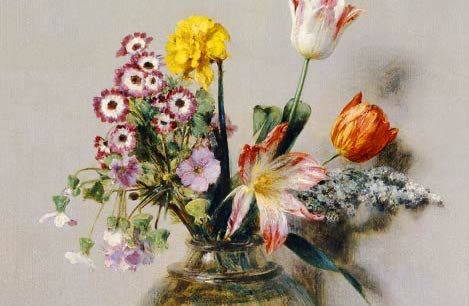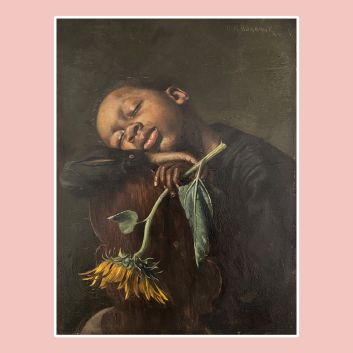Rating and value of works, paintings, drawings by Henri Fantin-Latour

If you own a work by or after Henri Fantin-Latour, and would like to know its value, our state-approved experts and auctioneers will be happy to offer you their appraisal services.
Our specialists will carry out a free appraisal of your work, and provide you with a precise estimate of its current market value.
Then, if you want to sell your work, we'll point you in the right direction to get the best possible price for it.
Rating and value of the artist Henri Fantin-Latour
Fantin-Latour is a symbolist and realist artist. His legacy consists mainly of paintings and drawings. Today, prices for his works are skyrocketing under auctioneers' gavels.
His flower still lifes are particularly prized by English and American buyers, and the prices at which they sell on the art market range from €10 to €3,712,930, a considerable delta but one that speaks volumes about the value that can be attributed to Fantin-Latour's works.
In 2022, a painting entitled Nature morte aux reines-marguerites sold for €1,918,070, whereas its estimate was between €697,480 and €929,970. The artist's value is very high, and varies according to the number of works on the auction market.
Order of value from a simple work to the most prestigious
Technique used | Results |
|---|---|
From €10 to €28,740 | |
Drawing - watercolor | From €85 to €102,640 |
Paint | From €500 to €3,712,930 |
Response in less than 24h
Style and technique of the artist Henri Fantin-Latour
Henri Fantin-Latour, a pivotal figure of the 19th century, is known for his exceptionally elegant still lifes of flowers. His style is characterized by a classical rigor, inherited from the academic tradition, but enriched by a modern sensibility.
He favors meticulous realism, where every detail, from the velvety softness of a petal to the texture of a vase, is captured with remarkable finesse. The choice of a subtle palette, dominated by pastel tones and muted nuances, reinforces this impression of softness and tranquility.
This technical refinement is combined with a composition that is always carefully orchestrated, where harmony and balance play an essential role.
He works with light with particular care, staging his bouquets like precious objects, bathed in a diffused light that seems to suspend them in time.
Fantin-Latour, while moving away from Impressionist boldness, opts for a more intimate, contemplative style, revealing an unrivalled mastery of floral painting.
He follows in the stylistic vein of several artists, including his wife, Victoria Fantin-Latourwith whom he collaborated, as well as older artists such as Anne Vallayer-Coster. In addition, several artists have been influenced by his work, including Paul Aïzpiri.

Henri Fantin-Latour, master of flower still lifes
Henri Théodore Fantin-Latour (1836-1904) is recognized as an indisputable master of flower still lifes, bringing his own depth and elegance to this often disparaged genre.
Born in Grenoble, he received his early artistic training from his father, Théodore Fantin-Latour, before moving to Paris in 1850.
Enrolled at the Petite École de Dessin, then the Beaux-Arts de Paris, he perfected his technique with Edgar Degas and developed a taste for self-portraiture.
It was in London, where he was a regular visitor, that his career really took off. His works were well received, particularly by British collectors.
During this period, he also learned the art of engraving from Edwin Edwards, which enriched his artistic vocabulary. His still lifes, particularly those of flowers, began to enjoy growing success, thanks in part to his exhibitions at London's Royal Academy.
Fantin-Latour deliberately chose to devote himself to still life, a genre considered minor by the Académie des Beaux-Arts.
He saw this as an opportunity to demonstrate that flower painting could equal, if not surpass, the great historical subjects through the subtlety of its composition and mastery of light.
In France, although he exhibited alongside major figures such as Manet, Renoir and Monet, he maintained a more traditional approach, preferring finesse and meticulousness to the boldness of the Impressionists.
Married to Victoria Dubourg, also a painter, Fantin-Latour found their union a source of inspiration and artistic support. While his still lifes remain his most famous work, his affiliation with Symbolism is more apparent in his etchings.
He died in 1904 in Buré, leaving behind him an artistic legacy deeply marked by his sense of detail and his attachment to the simple beauty of flowers, works today considered timeless masterpieces.

Fantin-Latour's legacy
Fantin-Latour left behind an artistic legacy marked by an unrivalled mastery of the still life and a versatility that was rare in his time.
His works, admired as much for their technical precision as for their emotional depth, continue to fascinate and bear witness to his importance in 19th-century art history.
He died leaving behind an imposing body of work that heralded future trends, notably in its attention to almost photographic detail. His interest in photography, evident in his collection of erotic snapshots, reflects an artistic curiosity that went beyond painting.
Private collectors have played an essential role in preserving his work, although some of his pieces have found their way into museums.
Despite his discreet character, Fantin-Latour's influence endures, both in the gentleness of his floral compositions and in his subtle approach to symbolism, which is particularly evident in his prints.
One work, one look: By the table by H. F-L.
Focus on Roses in a dish, Henri Fantin-Latour
Roses in a dish: a celebration of ephemeral beauty
In "Roses in a Dish", Henri Fantin-Latour plunges us into a delicate and refined exploration of still life. This work, emblematic of his talent, reveals a gentle gesture and a subtle balance between color and light, offering a poetic vision of flowering.
Each flower is painted with remarkable meticulousness, capturing the velvety texture of their petals and the richness of their nuances.
Fantin-Latour succeeds in bringing each rose to life, making them almost palpable. The composition exudes a soothing sensuality, an atmosphere of serenity that invites contemplation.
The pure white dish serves as a showcase for these dazzling flowers. Its elegant, slightly curved shape creates a harmonious contrast with the density of the roses, offering a visual balance that seems to defy gravity.
The choice of this modest yet refined container underlines the idea that beauty can be found in simplicity. It reminds us that nature itself, often perceived as extravagant, finds its value in everyday, accessible elements.
The subtly nuanced background plays a vital role in the composition. Like a delicate fog, it envelops the roses and the dish, softening the contours while accentuating the vibrant colors.
This almost ethereal atmosphere creates an effect of depth that evokes an intimate, secret space, where the viewer can get lost in the details.
Soft shadows glide across the canvas, creating a play of light that highlights the beauty of the flowers, almost as if they were glowing from within.
Every detail of this work reveals Fantin-Latour's passion for nature and his commitment to art. The roses, in particular, are not just flowers; they embody a reflection on the transience of life.
Their delicate forms and ephemeral brilliance are a reminder that beauty does not last, that it is both precious and fragile. This reflection invites the viewer to appreciate this suspended moment, to celebrate nature while accepting its impermanence.
Fantin-Latour never hesitated to explore symbolism in his painting. Roses can also be interpreted as symbols of love and passion, adding an emotional dimension to the work.
In this way, Roses in a Dish not only depicts flowers, but rises to a deeper level of meaning, touching on the universal of human feelings.
Fantin-Latour's technical mastery is also evident in his ability to capture variations in light and color.
The luminous reflections on the petals add an almost three-dimensional dimension to the whole, making the work vibrant and alive. Skilfully placed touches of white and yellow create a contrast that reinforces the richness and brilliance of the roses.
In conclusion, Roses in a Dish is much more than a simple still life; it's an ode to the fleeting beauty of life. Through this work, Fantin-Latour reminds us that art can transcend the everyday, transforming fleeting moments into eternal memories.
The artist's legacy lives on, like the roses themselves, embodying a beauty that remains etched in the mind, reminding us all of the power of art to capture the moment.
Recognizing Fantin-Latour's signature
Artists do not always sign their works. If you think you own one, it's best to have it appraised. The signature may differ depending on the type of work: sculpture, drawing or painting. There are also copies, which is why an appraisal is important.

Knowing the value of a work
If you happen to own a painting by Henri-Fantin Latour, or one based on the artist, don't hesitate to ask for a free estimate using the form on our website.
A member of our team of experts and certified auctioneers will contact you promptly to provide you with an estimate of the market value of your work, as well as any relevant information about it.
If you're thinking of selling your work of art, our specialists will also be on hand to help you find alternatives for selling it at the best possible price, taking market trends into account.
Response in less than 24h
Related topics

Rating and value of works, drawings, paintings by Lazare Brua...
Lazare Bruandet was a landscape painter of the early 19th century. His paintings are appreciated and sought-after at auction.
Read more >

Rating and value of works, drawings, paintings by Alphonse O...
Alphonse Osbert was a Symbolist painter of the 19th and 20th centuries who produced a number of paintings that were highly prized at auction.
Read more >

Rating and value of paintings by Stanislas...
Stanislas Lépine was a 19th-century landscape painter who produced many works that are highly valued at auction.
Read more >
Secure site, anonymity preserved
State-approved auctioneer and expert
Free, certified estimates





